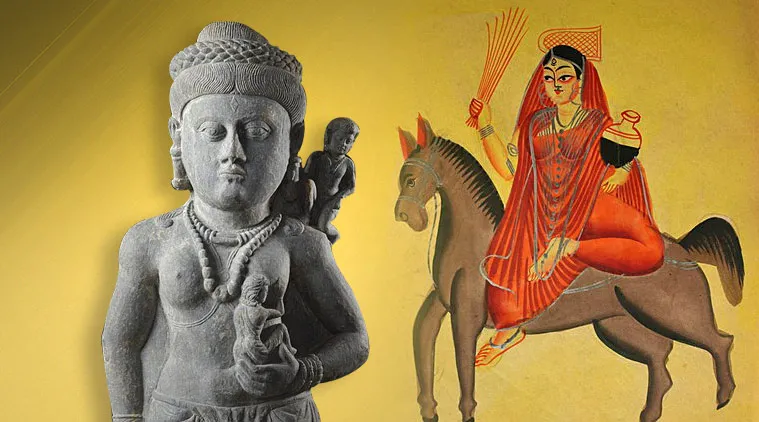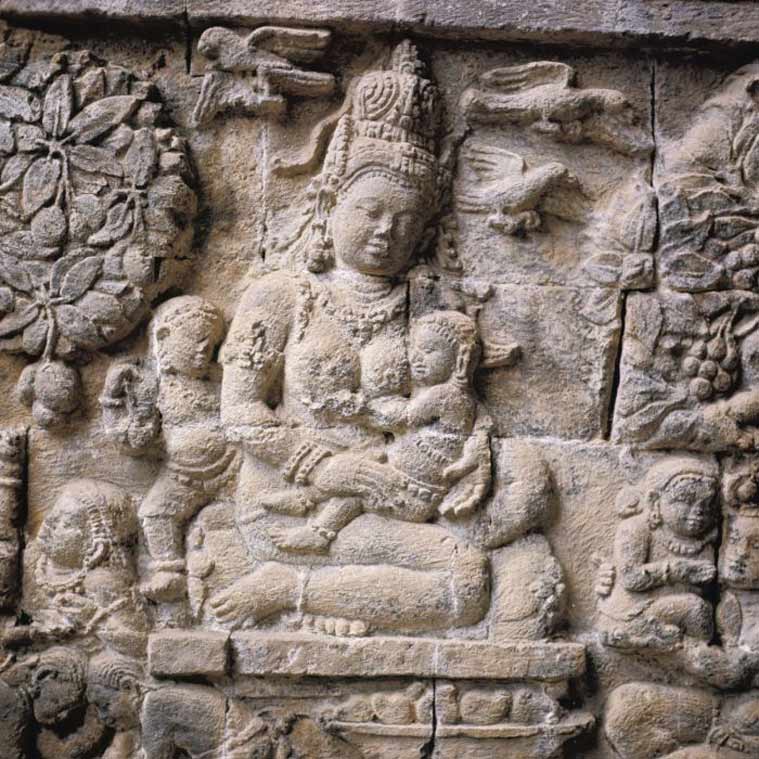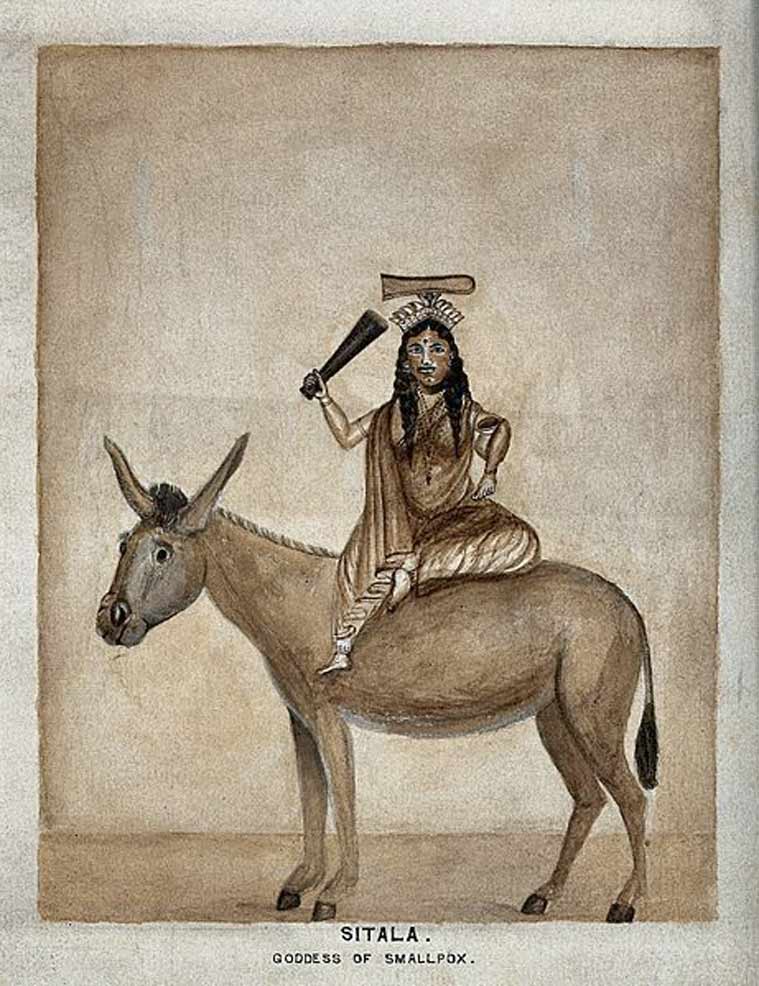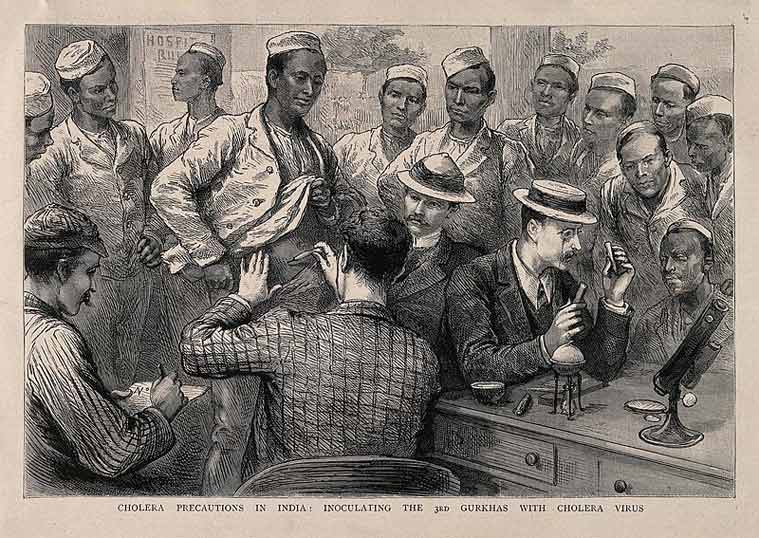- India
- International
When fear leads to faith: The disease Gods of India
Resorting to faith in times of distress has been an inherent human reaction since the beginning of civilisation. In India worship of Goddess Hariti, Sitala, Ola Bibi has been prevalent to ward off diseases.
 Goddess Hariti and Goddess Sitala (Source: Wikimedia Commons)
Goddess Hariti and Goddess Sitala (Source: Wikimedia Commons)
“I am worshipping the coronavirus as a goddess and doing daily pujas for the safety and well being of healthcare professionals, police personnel and scientists, who are toiling to discover a vaccine.” Anilan, a temple priest at Kadakkal in Kollam district of Kerala, gives the reason behind the ‘Corona devi’ idol he’s now offering daily prayers to. Faraway, in Biswanath district of northern Assam, a group of women recently assembled on the banks of a river to perform a puja to ‘Corona ma’, who they believe will destroy the virus that has killed thousands across the globe. Similar images of women offering prayers to Goddess ‘Corona mai’ have also emerged from Sindri and Bokaro in Jharkhand as well.
‘My own way of creating awareness’: Man in Kerala worships ‘Corona Devi’
While these images from Kerala, Assam and Jharkhand have resulted in angry social media responses, resorting to faith in times of distress has been an inherent human reaction since the beginning of civilisation. The British polymath Bertrand Russell had in his famous lecture titled ‘Why I am not a Christian’ delivered in 1927 at London, expressed that “fear is the foundation of religion’.
“Religion is based, I think, primarily and mainly upon fear. It is partly the terror of the unknown, and partly, as I have said, the wish to feel that you have a kind of elder brother who will stand by you in all your troubles and disputes. Fear is the basis of the whole thing—fear of the mysterious, fear of defeat, fear of death.”
One of the most common religious manifestations of fear is that of the snake God. “Throughout history, humans have had an uneasy relationship with serpents. Snakes are important in many religions including the Judeo-Christian tradition, Hinduism, Egyptian and Greek mythology, and Native American religions, among others. This prominence in so many religions may be the result of humans’ fear of snakes,” writes Jonathan W. Stanley in his research paper, ‘Snakes: Objects of Religion, Fear, and Myth’. In Indian religious tradition too, snakes are worshipped in different parts of the country in different ways.

 Worship of snake Gods in India (Source: Wikimedia Commons)
Worship of snake Gods in India (Source: Wikimedia Commons)
Yet another example of fear giving rise to religion is that of the multitude of war deities. While Indra and Kartikeya have been associated with war in Hinduism, Mars was the God of War in ancient Roman religion, Ogun is the God of war in several African religions.
The fear of diseases and the resultant suffering, have also given rise to several religious manifestations. The first plague in human history, also known as the Justinian Plague in the sixth century CE, was seen as an act of angry Gods. “There is no single or predictable response to epidemic disease. Nor is it correct to assume that religious responses are always apocalyptic,” writes historian Duane J. Osheim in his research paper, ‘Religion and epidemic disease’. “It might be better to recognise that religion, like gender, class, or race, is a category of analysis. The religious response to epidemic disease may best be seen as a frame, a constantly shifting frame, subtly influencing illness and human responses to it,” he adds.
Hariti: The Buddhist Goddess who protects children from smallpox
One of the earliest iconographic traditions we have of a Goddess being worshipped to ward off a disease is that of Hariti. Several statues of Hariti with her brood of children have been excavated from territories ruled by the Kushana dynasty in the early centuries in the Christian era. The Kushanas had inherited the Graeco-Buddhist religion from the Indo-Greek kingdom they replaced, which explains the popularity of Hariti in Buddhist tradition.
The first smallpox outbreak in the world is known to have been in the fifth century BCE in Europe. When it first occurred in India is hard to tell, but records of Chinese visitors to India I-Tsing and Xuanzang in the sixth and seventh century CE, shows the popularity of Hariti statues across every Buddhist monastery in the subcontinent. Given that smallpox was often considered to be a disease that primarily affected children, Hariti was worshipped for the overall wellbeing of children, childbirth, fertility, as well as for warding away diseases afflicting children.
However, scholars have remarked upon the fact that Hariti was introduced into Buddhist tradition from rural and tribal folklore wherein smallpox Goddesses were worshipped from much before. Historian Sree Padma, in her work, ‘Hariti: Village origins, Buddhist elaborations, and Saivite accommodations’, notes that Goddess Hariti had folk origins in Andhra Pradesh where she was known as Goddess Erukamma. “The Goddess of smallpox and other contagious diseases who are also regarded as guardian deities are ubiquitous in Andhra. The names of these smallpox Goddesses might vary from region to region. Some of these are called Mutyalamma, Pochamma, Peddamma, Nukalamma, Ankalamma etc.,” she writes. Padma goes on to explain that “some smallpox Goddesses are deified human women who died during their pregnancies or when delivering children. Devotees believed that the spirits of these women would bring destruction and death to their children unless they are approached with proper offerings and prayers.”
 Several statues of Hariti with her brood of children have been excavated from territories ruled by the Kushana dynasty in the early centuries in the Christian era. (Source: Wikimedia Commons)
Several statues of Hariti with her brood of children have been excavated from territories ruled by the Kushana dynasty in the early centuries in the Christian era. (Source: Wikimedia Commons)
The folk Goddess was later incorporated into Buddhist tradition where she was revered for protection of children and fertility. Archaeological evidence shows that images of Hariti appeared during the period of Mahayana Buddhism between 150 BCE and 100 CE, and spread beyond the Indian subcontinent to be part of the Buddhist cultural world in central, east and south-east Asia.
Belgian priest and scholar of Buddhism Entienne Lamotte, in his 1988 book ‘History of Indian Buddhism’, notes that “she is still invoked in Nepal as the Goddess curing smallpox, and the monks are expected to ensure her daily nourishment”. He goes on to elaborate that images of Hariti are widespread, the most famous one being at a site in Peshawar. “She carries a standing child in her hand and two others on her shoulders; the plinth is engraved with an inscription, from the year 179 (or 139) of an unknown era, begging the Goddess to take smallpox away into the sky,” he notes.
Sitala: The cooling Goddess of Smallpox
By the 19th century, British physicians in India ranked smallpox among the most prevalent and destructive of all epidemic diseases. Historian David Arnold in his book, ‘Colonising the body: State medicine and epidemic diseases in nineteenth century India’ notes that “Smallpox accounted for several million deaths in the late nineteenth century alone, amounting on average to more than one hundred thousand fatal cases a year.”
Believed to be an incarnation of the Hindu Goddess Durga, Sitala, or simply ‘mata’ (mother), was widely worshipped in the 19th century in Bengal and North India, as one who can cure smallpox. Anthropologist, Ralph W. Nicholas in his research paper, ‘The Goddess Śītalā and Epidemic Smallpox in Bengal’ observes that “there is no evidence of the Goddess of Smallpox before the tenth to twelfth centuries, and she appears to have attained her present special significance as goddess of the village in southwestern Bengal abruptly in the eighteenth century”.
 Believed to be an incarnation of the Hindu Goddess Durga, Sitala, or simply ‘mata’ (mother), was widely worshipped in the 19th century in Bengal and North India, as one who can cure smallpox. (Source: Wikimedia Commons)
Believed to be an incarnation of the Hindu Goddess Durga, Sitala, or simply ‘mata’ (mother), was widely worshipped in the 19th century in Bengal and North India, as one who can cure smallpox. (Source: Wikimedia Commons)
Despite the fact that there were several other Goddesses of smallpox in 18th-19th century Indian folklore, Sitala seems to have enjoyed a special position. What is interesting is that while she was revered as a Goddess, Smallpox was believed to be a manifestation of her personality. “The burning fever and pustules that marked her entry into the body demanded ritual rather than therapeutic responses. To some Hindus, recourse to any form of prophylaxis or treatment was impious, likely to provoke the Goddess and further imperil the child in whose body she currently resided,” writes Arnold.
Sitala, meaning the ‘cool one’, was to be pacified with cooling substances such as curd, plantains, cold rice, and sweets. “Similarly, when an attack of smallpox occurred, cooling drinks were offered to the patients as the abode of the Goddess, and his or her feverish body was washed with cold water or soothed with the wetted leaves of the neem (or margosa), Shitala’s favourite tree,” explains Arnold.
It is fascinating to note that despite smallpox being eradicated from India in the 1970s, Sitala continues to hold a place of reverence in large parts of the country.
Ola chandi/bibi: The Cholera Goddess
Yet another deadly epidemic of 19th century India was Cholera. Even though references to Cholera occurs in ancient medical works of Hindus, Arabs, Chinese, Greeks, and Romans from the fourth century BCE, the disease acquired a whole new status in the nineteenth century, when a total of five Cholera pandemics claimed the lives of millions across the world.
Consequently, the ritualisation of Cholera is believed to have started after the pandemic of 1817. “Only in deltaic Bengal, is there known to have been worship of a specific Cholera deity, called Ola Bibi by Muslims, and Olai-Chandi by Hindus,” writes Arnod. He adds that “before 1817 the Goddess enjoyed far less popular devotion than Sitala, but she was thereafter extensively propitiated during the season when cholera was most prevalent.”
Reports by European missionaries mentioned in Arnold’s book suggests that reverence for the Goddess often manifested itself in young girls dressing up as Ola Bibi/ Chandi to receive her worship. Apart from Bengal, she is also worshipped in Rajasthan as the deity who saves her devotees from cholera, jaundice, diarrhea, and other stomach related diseases.
 Cholera acquired a whole new status in the nineteenth century, when a total of five Cholera pandemics claimed the lives of millions across the world. (Source: Wikimedia Commons)
Cholera acquired a whole new status in the nineteenth century, when a total of five Cholera pandemics claimed the lives of millions across the world. (Source: Wikimedia Commons)
Few other deities invoked by the fear of diseases include Ghentu-debata, the God of skin diseases, and Raktabati, the Goddess of blood infections.
While resorting to religion has been a natural human response to fear, scientific intervention has started obliterating the same. As Russell noted in his lecture: “Science can teach us, and I think our own hearts can teach us, no longer to look round for imaginary supports, no longer to invent allies in the sky, but rather to look to our own efforts here below to make this world a fit place to live in.”
Further reading:
Religion and epidemic disease by Duane J. Osheim
Hariti: Village Origins, Buddhist Elaborations and Saivite Accommodations by Sree Padma
History of Indian Buddhism by Etienne Lamotte
Colonizing the Body: State Medicine and Epidemic Disease in Nineteenth-Century India by David Arnold
The Goddess Śītalā and Epidemic Smallpox in Bengal by Ralph W. Nicholas
Apr 25: Latest News
- 01
- 02
- 03
- 04
- 05







































